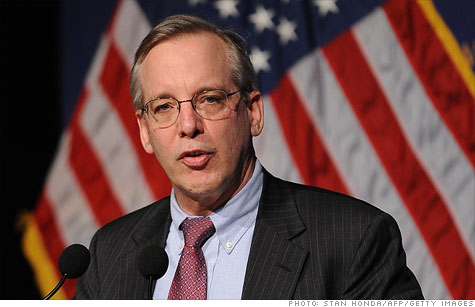
Job seekers at a federal government job fair at the National Building Museum in Washington. Photographer: Xinhua/ZUMApress.com
Claims for jobless benefits unexpectedly dropped last week to the lowest level in four years, showing the U.S. job market is on the mend.
Applications (INJCJC) for unemployment insurance payments decreased 13,000 in the week ended Feb. 11 to 348,000, less than the lowest forecast of economists surveyed by Bloomberg News and the fewest since March 2008, Labor Department figures showed today. The median survey estimate projected an increase to 365,000.
The slowdown in dismissals coincides with a pickup in hiring and a drop in unemployment that’s helping repair a labor market still recovering from the 18-month recession that ended in June 2009. More job gains are needed to boost household spending, the biggest part of the world’s largest economy.
“It’s clearly reflecting a rapidly improving labor market, signaling further declines in the jobless rate,” said Sal Guatieri, a senior economist at BMO Capital Markets in Toronto. “It’s good news for consumers, meaning stronger income growth and likely rising confidence that will support spending.”
Estimates for first-time claims ranged from 350,000 to 380,000 in the Bloomberg survey of 45 economists. The Labor Department revised the prior week’s reading up to 361,000 from an initially reported 358,000.
Wholesale prices rose less than forecast in January as food and energy costs dropped, a sign inflation pressures may remain subdued, another report from the Labor Department showed today.
Wholesale Prices
The producer price index rose 0.1 percent following a 0.1 percent decrease the prior month. Economists projected a 0.4 percent gain, according to the survey median. The core measure excluding volatile food and energy rose 0.4 percent, more than projected, led by a surge in drug prices.
The number of people continuing to collect jobless benefits dropped by 100,000 in the week ended Feb. 4 to 3.43 million, the fewest since August 2008. The continuing claims figure does not include the number of workers receiving extended benefits under federal programs.
Builders broke ground on more homes than forecast in January, helped by warmer weather and adding to signs the residential real-estate market is stabilizing, data from the Commerce Department also showed today.
More Starts
Starts rose 1.5 percent to a 699,000 annual rate from December’s 689,000 pace that was stronger than previously reported. The median estimate in a Bloomberg survey called for a rise to 675,000. Building permits, a proxy for future construction, also climbed.
Stock-index futures trimmed earlier losses after the reports. The contract on the Standard & Poor’s 500 Index maturing in March fell 0.1 percent to 1,340.3 at 8:47 a.m. in New York as euro area’s leaders remained divided over a bailout for Greece and Moody’s Investors Service reviewed global banks.
Those who’ve used up their traditional benefits and are now collecting emergency and extended payments decreased by about 22,800 to 3.48 million in the week ended Jan. 28.
The unemployment rate among people eligible for benefits fell to 2.7 percent in the week ended Feb. 4 from 2.8 percent, today’s report showed. Forty-four states and territories reported a decrease in claims, while nine showed an increase.
The figures follow a report earlier this month that showed improvement in the labor market. Employers added 243,000 jobs in January, the most since April, and the unemployment rate dropped to a three-year low of 8.3 percent, according to the Labor Department.
Firing, Hiring
Initial jobless claims reflect weekly firings and tend to fall as job growth -- measured by the monthly non-farm payrolls report -- accelerates.
The drop in joblessness over the last few months stems in part from fewer workers in the labor force, according to some Federal Reserve officials.
“A few participants noted that the recent decline in the unemployment rate reflected declining labor force participation in large part, and judged that the decline in the participation rate was likely to be reversed, at least to some extent, as the recovery continues and labor demand picks up,” according to minutes of the Federal Open Market Committee meeting Jan. 24-25 released yesterday in Washington.
Increased demand is prompting some firms to boost their payrolls. “Employee levels rose 5 percent as we continue to hire trainees to handle our 2012 forecasted volumes,” James Squires, chief financial officer for Norfolk Southern Corp. (NSC), the second-biggest railroad company in the eastern U.S., said on a Feb. 14 conference call.
To contact the reporters on this story: Timothy R. Homan in Washington at thoman1@bloomberg.net; Robert Willis in Washington at bwillis@bloomberg.net



